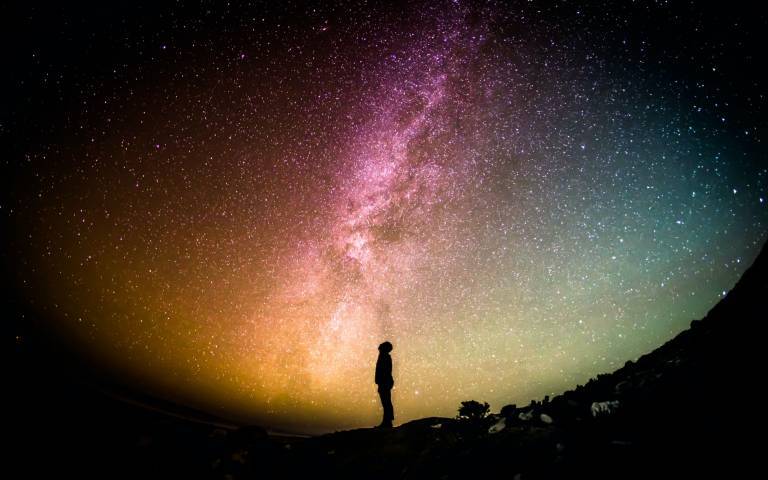Five-year quest to create 3D map of the universe
18 May 2021
A five-year mission to create an unprecedented 3D map of the universe using the Dark Energy Spectroscopic Instrument (DESI), designed and built in part by UCL physicists, formally starts today.

DESI will capture and study light from tens of millions of galaxies and other distant objects with the aim of unravelling the mysteries of “dark energy”, which is believed to be driving the accelerating expansion of the universe.
The instrument, based at Kitt Peak National Observatory near Tucson, Arizona, in the United States, contains 5,000 fibre-optic “eyes”, each of which can image a galaxy in just 20 minutes. In a four-month trial run, DESI captured four million spectra – more than the combined output of all previous spectroscopic surveys.
Professor Ofer Lahav, (UCL Physics & Astronomy), chair of the DESI UK consortium of seven universities, said:
““This survey will go deeper into space and the history of the Universe than we have ever achieved before, and follows years of efforts of building DESI by the international collaboration, including by UCL and Durham’s instrumentation teams."
“DESI is a revolution in astronomy, collecting spectra from 5,000 galaxies every 20 minutes. It will lead to unprecedented observations that will help us characterise the mysterious nature of dark energy.”
Michael Levi, the Director of DESI based at the US Department of Energy’s Lawrence Berkeley National Laboratory (Berkeley Lab), the project’s lead institution, said: “We will measure 10 times more galaxy spectra than ever obtained. These spectra get us a third dimension.” Instead of two-dimensional imaging of galaxies, quasars, and other distant objects, he explained, the instrument collects light, or spectra, from the cosmos such that it “becomes a time machine where we place those objects on a timeline that reaches as far back as 11 billion years ago.”
DESI is mounted on a four-metre telescope whose top end is replaced with DESI’s optical corrector, built by a team including UCL physicists. This corrector, which houses six lenses, the largest 1.1m across, reflects light on to the fibre-optic “eyes” that move independently to capture light from individual galaxies. It also expands the telescope’s viewing window by about 16 times.
The captured light is then split into bands of colour by spectrographs to map the movements of the galaxies relative to Earth, revealing the expansion history of the universe.
Dr David Brooks and Professor Peter Doel (both UCL Physics & Astronomy) helped design, assemble and build the optical corrector at UCL.
Professor Doel said: “The design, assembly and testing of the large multiple lens system that is the DESI optical corrector was a major undertaking of UCL’s Optical Science Laboratory. To provide the sharpest of images, each of the six lenses were aligned to an extremely high accuracy – less than half of a hair’s thickness. This precision is maintained as the telescope moves to image the night sky.
“We’re very happy with its excellent performance during the trial runs of the instrument. It’s exciting that the full survey is starting and I look forward to all the science discoveries the new data will reveal.”
As DESI collects data during its five-year survey, UCL astronomers will be analysing it to reveal the secrets of the universe.
Professor Amelie Saintonge (UCL Physics & Astronomy) said: “After years of planning and discussing the science that DESI will make possible, it is very exciting to see the data pour in and start working on better understanding how galaxies grow and how they relate to the dark matter and dark energy framework of the Universe.”
Spectra collected by DESI are the components of light corresponding to the colours of the rainbow. Their characteristics, including wavelength, reveal information such as the chemical composition of objects being observed as well as information about their relative distance and velocity.
As the universe expands, galaxies move away from each other, and their light is shifted to longer, redder wavelengths. The more distant the galaxy, the greater its “redshift.” By measuring galaxy redshifts, DESI researchers will create a 3D map of the universe. The detailed distribution of galaxies in the map is expected to yield new insights on the influence and nature of dark energy.
DESI is a collaboration involving hundreds of scientists around the world. In the UK it receives funding from the Science and Technology Facilities Council (STFC). Its primary funder is the US Department of Energy’s Office of Science.
Other UK institutions involved include the universities of Durham, Portsmouth, Edinburgh, St Andrews, Cambridge and Warwick.
Professor Grahame Blair, STFC Executive Director for Programmes, said: “The start of the survey work with DESI marks the start of an exciting journey to answer an enduring mystery about the very fabric of the universe.
“DESI gives us the opportunity to explore the nature of dark energy, potentially one of the major forces shaping the universe.
“This international collaboration applies the best cutting-edge technology and expertise from across the globe to reveal more about the unknown universe than ever before. It is great that UK scientists are playing such a strong role in this scientific adventure.”
Image
- Photo by Greg Rakozy on Unsplash
Video: A 3D journey provided by DESI, following the path of light 11 billion years backwards through nearby bright galaxies (yellow), luminous red galaxies (red), emission-line galaxies (green), and quasars (blue) that back-light the tenuous intergalactic medium (white lines). The long, thin volume of the universe shown here fits behind your palm held at arm's length and shows 30 thousand galaxies measured by DESI in 5 hours. DESI will survey almost one thousand times more volume over the next five years. (credit: David Kirkby/DESI collaboration)
 Close
Close

